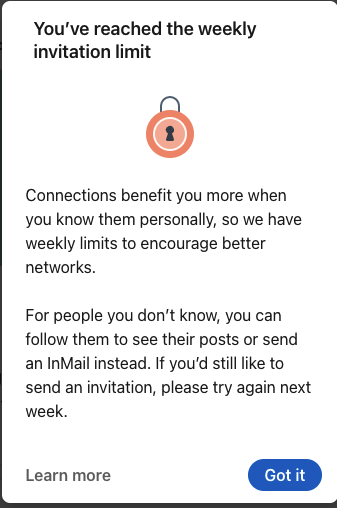Ever felt like you're on a networking spree on LinkedIn, only to be hit with a limit on how many invitations you can send? You're not alone! Many users have questions about these restrictions and how they can impact their professional connections. In this post, we’ll dive into the specifics of LinkedIn's invitation limits, helping you navigate your networking efforts more effectively.
Understanding LinkedIn Invitation Limits
LinkedIn has implemented invitation limits to maintain the quality of connections on its platform. These limits are designed to prevent spammy behavior and ensure that users are genuinely interested in connecting with others. So, how does it all work?
Each week, LinkedIn allows you to send a certain number of connection requests, which varies based on several factors:
- Your account age: New accounts often have stricter limits to discourage spam. As your account ages and gains credibility, you'll find your limits increasing.
- Your connection acceptance rate: If many of your invitations are ignored or declined, LinkedIn might lower your sending limit. Keeping your invitations relevant and personalized can help improve this rate.
- LinkedIn Premium users: If you’re a Premium member, you enjoy higher limits compared to free users, allowing for more extensive networking opportunities.
Typically, the weekly limit for sending invitations ranges from 50 to 100 connections. However, this number isn't set in stone. If you approach the limit, you might see a notification, reminding you to be judicious with your invites.
To maximize your networking without hitting the limit, consider these tips:
- Personalize your invites: Instead of sending a generic message, take a moment to explain why you want to connect. This can lead to higher acceptance rates.
- Engage with shared content: Before sending an invite, interact with potential connections by liking or commenting on their posts. This can increase the likelihood of them accepting your request.
- Quality over quantity: Focus on building meaningful relationships rather than simply expanding your network. A smaller, engaged network is often more valuable than a large one filled with unresponsive contacts.
Understanding these limits can not only save you from the frustration of being blocked from sending invites but also enhance the quality of your professional network. The key is to be strategic in your approach and make genuine connections rather than just increasing your numbers.
Also Read This: How to Reach LinkedIn Support Without Logging In: Tips and Tricks
3. Factors Influencing Sending Limits
When it comes to LinkedIn invitations, you might be curious about why there’s a limit on how many you can send each week. Several factors come into play, affecting this limit and making it a bit of a mystery, even for seasoned users. Let’s dive into some of the key factors influencing these sending limits.
- Account Age: New LinkedIn accounts typically have stricter limits compared to established ones. If you just created your profile, you might find yourself restricted to fewer invitations. This is LinkedIn's way of preventing spam and encouraging genuine connections.
- Connection Behavior: Your past activity matters! If you frequently send invites but have a high rejection rate, LinkedIn may lower your limits to discourage spammy behavior. It’s all about maintaining a healthy network.
- Engagement Levels: The more actively you engage with your connections—through comments, likes, or shares—the more likely LinkedIn will allow you to send more invitations. High engagement shows that you’re genuinely interested in building relationships.
- Profile Completeness: A fully completed profile may positively influence your invitation limits. Make sure to add a professional photo, a compelling summary, and relevant experience to increase your credibility on the platform.
Understanding these factors can help you navigate LinkedIn more effectively, ensuring you're using your invitation capacity wisely. Remember, it's not just about quantity; quality connections make a world of difference!
Also Read This: How to Add Organizations to Your LinkedIn Profile for Greater Impact
4. Best Practices for Sending Invitations
Now that we’ve explored what influences LinkedIn’s invitation limits, let’s discuss some best practices for sending those invitations. After all, sending an invitation is just the first step—making meaningful connections is the ultimate goal!
- Personalize Your Invitations: Always take a moment to craft a personalized message when sending an invitation. Mention how you know the person, why you want to connect, or something you admire about their work. This simple touch can significantly improve your acceptance rate.
- Focus on Quality Over Quantity: Instead of blasting out invitations to anyone and everyone, target individuals who align with your professional goals. This could be colleagues, industry leaders, or even alumni from your school.
- Follow Up Thoughtfully: If someone accepts your invitation, don’t just let it sit there! Send a follow-up message to thank them and perhaps initiate a conversation. This can lay the foundation for a fruitful relationship.
- Engage with Their Content: Once connected, actively engage with their posts by liking, commenting, or sharing. This not only keeps you on their radar but also shows that you value their insights and contributions.
By implementing these best practices, you’re not just sending out random invitations but building a meaningful network that can lead to exciting opportunities. Remember, LinkedIn isn’t just about collecting connections; it’s about cultivating relationships that can enhance your professional journey!
Also Read This: How to Follow Someone on LinkedIn for Professional Networking
5. Strategies to Increase Your Network Effectively
Growing your LinkedIn network is not just about sending out invitations; it's about building meaningful connections. Here are some strategies to help you expand your network effectively:
- Personalize Your Connection Requests: Always include a personalized message when sending a connection request. Mention how you know them or why you’d like to connect. For example, "Hi [Name], I enjoyed your recent post about [topic]. I'd love to connect and share insights!"
- Engage with Content: Liking, commenting, and sharing posts from your connections can make you more visible in their network. It’s a great way to showcase your interests and expertise.
- Participate in Groups: Join LinkedIn groups related to your industry. Engage in discussions and share your thoughts. This builds your reputation and can lead to connection requests from group members.
- Attend Networking Events: Look for virtual or local LinkedIn events. Meeting people in a professional setting makes it easier to connect afterwards. Always follow up with a connection request!
- Utilize Alumni Networks: Reach out to fellow alumni from your university or past workplaces. Shared experiences can make for a strong foundation in networking. You can say something like, "I see we both graduated from [University]. I'd love to connect!"
Remember, the goal is not just to collect connections but to cultivate relationships. Aim for quality over quantity. A well-maintained network can lead to new opportunities and collaborations!
6. Conclusion
In conclusion, while LinkedIn limits the number of invitations you can send each week, it encourages you to focus on building genuine connections. By implementing the strategies mentioned, you can effectively grow your network without hitting that limit.
Always keep in mind that networking is a marathon, not a sprint. Take the time to nurture your connections, engage with their content, and consider how you can offer value to them. Networking is about reciprocity; the more you give, the more you’ll receive.
As you navigate the world of LinkedIn, remember to track your invitations and connections. This will help you manage your weekly limits while ensuring that you’re connecting with the right people. Happy networking!

 admin
admin








